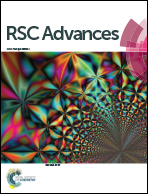Cu2S-incorporated ZnS nanocomposites for photocatalytic hydrogen evolution†
Abstract
Sodium Lauryl Sulphate (SLS) surfactant and propylene diamine (PD), assisted wet chemical synthesis was used to make ZnS–Cu2S nanoflakes wherein the added copper(II) transforms into copper(I) sulphide and is found to be deposited on the surface of ZnS. With a variation of copper concentration from 0 to 5% there is a morphological transformation from ZnS nanorods eventually to ZnS–Cu2S nanoflakes through a transition morphology of nanocactus leaves. During the addition of copper there is an incorporation of Cu2S into the ZnS phase (100) as is clearly evidenced by various characterization methods. Visible light photocatalytic hydrogen production activities using these nanoflakes of ZnS–Cu2S are reported with good results. The influence of Cu2S shifts the band gap of ZnS from the UV to the visible region, reducing the need for an expensive co-catalyst like platinum for photolysis of water. Though hydrogen production is not as high as that depicted by other earlier works the material that we have created is a relatively cheap, simple two component heterostructure with no expensive third component. It is also free from toxic materials such as CdS. However, our results are better than for most other copper loaded ZnS systems in the literature. Furthermore, the morphological evolution to nanoflakes from nanorods, the concentration and dispersion of Cu2S over ZnS and the interface between Cu2S and ZnS semiconductors play a vital role in hydrogen production. 5% Cu2S on ZnS seems to be the optimum concentration for maximum evolution of hydrogen.


 Please wait while we load your content...
Please wait while we load your content...